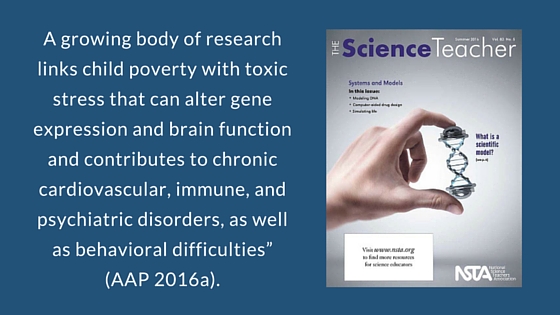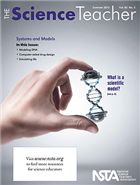Health Wise: Countering Poverty’s Effects on Learning
By Guest Blogger
Posted on 2016-07-30
Poverty is a student health problem, according to the 64,000-member American Academy of Pediatrics (AAP; 2016a).
The AAP announced earlier this year that at all checkups, pediatricians should ask parents and guardians: “Do you have difficulty making ends meet at the end of the month?” This question helps identify the one in five U.S. children who are living in poverty, or an income level at or below $24,230 for a family of four, according to 2015 U.S. Census Bureau data (2016). The number of poor children younger than 18 rises to 43%, or 31.5 million, when families designated as “poor,” “near poor,” and “low-income” are included in census data, according to the AAP (2016a).
“Research shows that living in deep and persistent poverty can cause severe, lifelong health problems, including … poor language development, higher rates of asthma, and obesity. A growing body of research links child poverty with toxic stress that can alter gene expression and brain function and contributes to chronic cardiovascular, immune, and psychiatric disorders, as well as behavioral difficulties” (AAP 2016a).
“While urban and rural areas continue to have high rates of poverty, the suburbs have experienced the largest and fastest increases in poverty since the 2008 recession,” the AAP says. “Poverty is everywhere. It affects children of all backgrounds and in all communities,” says AAP president Benard P. Dreyer (AAP 2016a).
Moreover, the consequences of poverty can limit educational achievement, the AAP says (2016b). Irwin Redlener, a professor of pediatrics at Columbia University, also wrote about the role poverty plays in education achievement in an Education Week commentary:
“Kids are sleeping at their desks after being up all night wheezing with untreated asthma. They are failing tests because they don’t have the glasses they need to read a lesson on the blackboard. They are being held back a grade because they can’t hear the teacher. They are acting out because they are traumatized by extreme stress in their home. These are the health burdens of poverty that weigh on children in classrooms every day” (Redlener 2014).
One study found that half of parents of uninsured children were unaware that their children were eligible for government health insurance. The study of 267 uninsured children in Texas found that 38% had health problems, 66% had special healthcare needs, and 64% had no primary care provider, although their parents or guardians were eligible for Medicaid and the Children’s Health Insurance Program (Flores et al. 2015).
“High school science teachers who believe poverty may be affecting their students’ health can talk with the principal, school nurse, or school counselor,” says Dr. Mary Lou Gavin, senior medical editor for KidsHealth.org. “Make sure low-income students are benefiting from school services, such as counseling and free or reduced-price breakfasts and lunches. Educators also can refer families to local, state, and federal resources that offer help with food, housing, heat, clothes, and health insurance.”
Michael E. Bratsis is senior editor for Kids Health in the Classroom. E-mail him with comments, questions, or suggestions.
On the web
For students:
Coping with stress articles, in English and Spanish: http://bit.ly/1T79DIf
For educators:
Poverty in schools: http://edut.to/1Mrni7P
At-Risk School Success Stories: http://bit.ly/1RWIFE5
How Being Poor Makes You Sick: http://theatln.tc/1vGeoxh
School breakfast, school lunch, and supplemental nutrition assistance programs: http://1.usa.gov/1AGZ71S, http://1.usa.gov/N9l7Oj, http://1.usa.gov/1gLikau
References
American Academy of Pediatrics (AAP). 2016a. American Academy of Pediatrics recommends pediatricians screen for poverty at check-ups and help eliminate its toxic health effects. http://bit.ly/1p8ykcP
American Academy of Pediatrics (AAP). 2016b. Poverty and child health in the United States. http://bit.ly/1RTcWiY
Flores, G., L. Hua, C. Walker, M. Lee, A. Portillo, M. Henry, M. Fierro, and K. Massey. 2016. A cross-sectional study of parental awareness of and reasons for lack of health insurance among minority children, and the impact on health, access to care, and unmet needs. International Journal for Equity in Health 15 (44). http://bit.ly/1Zps9y0
Redlener, I. Education Week. 2014. A Healthy Child Is a Better Student. August 5. http://bit.ly/XpBJqu
U.S. Census Bureau. 2016. Poverty. http://1.usa.gov/1z7zD9Z
This article was originally published in the Summer 2016 issue of The Science Teacher journal from the National Science Teachers Association (NSTA).
Get Involved With NSTA!
Join NSTA today and receive The Science Teacher, the peer-reviewed journal just for high school teachers; to write for the journal, see our Author Guidelines and Call for Papers; connect on the high school level science teaching list (members can sign up on the list server); or consider joining your peers at future NSTA conferences.
The mission of NSTA is to promote excellence and innovation in science teaching and learning for all.
Future NSTA Conferences
2016 Area Conferences
2017 Nati
onal Conference
Follow NSTA
Disclaimer: The views expressed in this blog post are those of the author(s) and do not necessarily reflect the official position of the National Science Teaching Association (NSTA).





